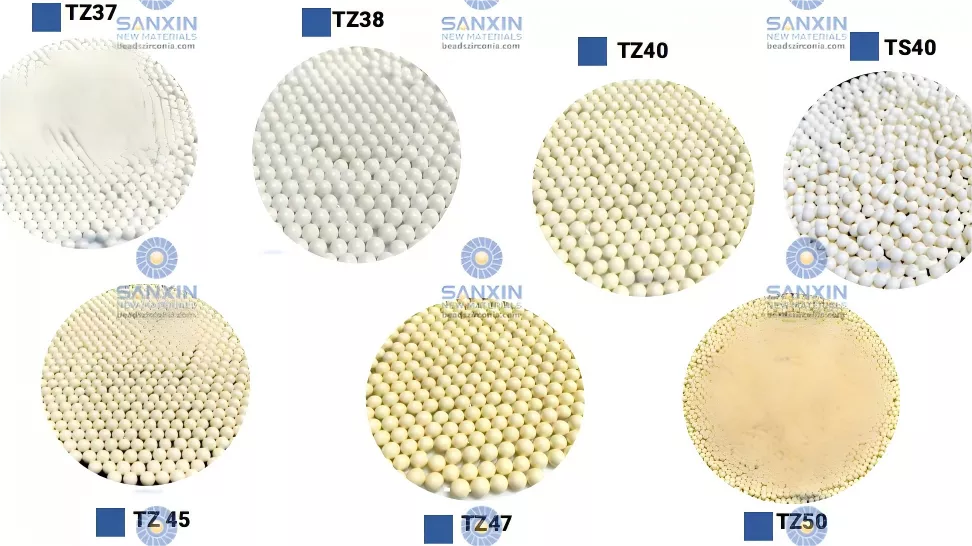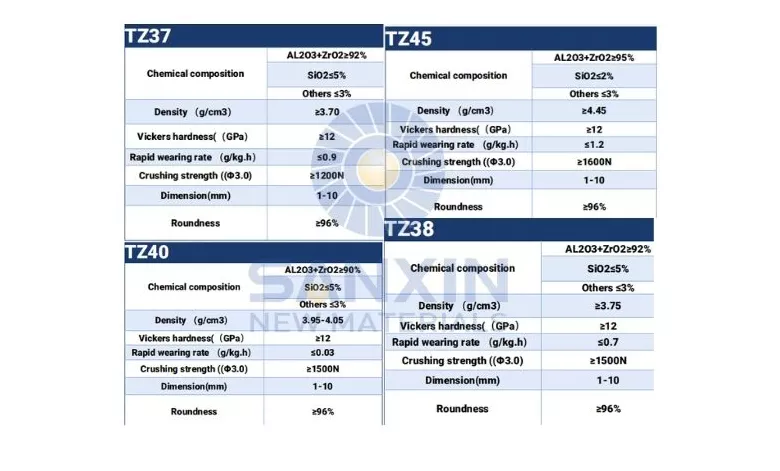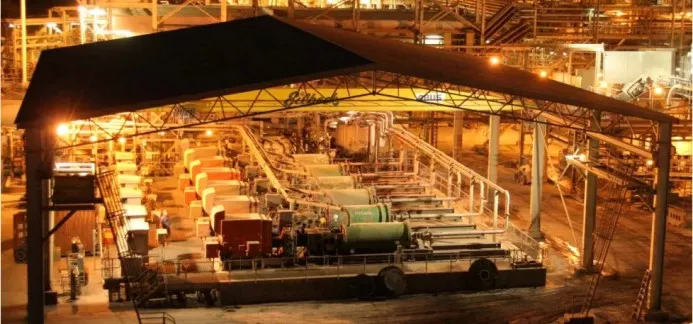In the high-stakes world of mineral processing, where efficiency, sustainability, and cost savings dictate success, the quest for superior grinding solutions has never been more critical. As global demand for metals like copper, gold, and rare earth elements surges—driven by the electric vehicle boom and renewable energy transitions—miners face mounting pressure to extract more value from increasingly complex ores. Enter ceramic grinding media, a game-changing innovation that's transforming fine and ultrafine grinding operations. This comprehensive guide explores a patented method using small-diameter ceramic balls (1-4mm) in medium-high speed stirred mills, delivering unparalleled efficiency in mineral fine grinding and ultrafine ore grinding.

Whether you're a mining engineer optimizing throughput or a plant manager eyeing energy reductions, this article dives deep into the science, implementation, and real-world impacts of ceramic grinding balls for mineral processing. We'll cover everything from composition and setup to case studies and 2025 market trends, helping you unlock 20-40% energy savings and boost liberation rates. By the end, you'll see why zirconia toughened alumina (ZTA) balls and similar ceramics are poised to dominate the industry. Let's grind down the barriers to peak performance.
Mineral grinding remains the cornerstone of beneficiation, accounting for up to 50% of a mine's energy consumption and directly influencing downstream recovery rates. Traditionally, ball mills—cylindrical drums filled with steel or iron balls—have dominated coarse grinding, cascading media to crush ores via impact and attrition. However, as ore grades decline and symbiosis between valuable minerals and gangue intensifies, the limitations of these systems become stark. Good ore is depleting; today's deposits demand fine grinding (P80 <75μm) or ultrafine grinding (P80 <20μm) to liberate locked particles, enabling effective flotation, leaching, or magnetic separation.
Enter the stirred mill revolution. Unlike ball mills' low-energy tumbling action, stirred mills (e.g., IsaMill, Vertimill) use a rotating impeller or agitator to suspend small media in a slurry, generating shear forces ideal for sub-micron sizes. Yet, even here, conventional media like 10-20mm steel balls falter. Large diameters hinder slurry flow, spike breakage under high shear (up to 10% loss per hour), and allow oversized particles to escape unground, reducing selectivity. Media consumption soars—often 1-2 kg/t ore—while energy efficiency plateaus at 10-15 kWh/t for ultrafine work.
This is where ceramic grinding media shines. Composed of high-purity alumina (Al2O3) or ZTA composites, these balls boast Mohs hardness ≥9, densities of 3.6-4.5 g/cm³, and diameters as small as 1mm. They address core pain points: poor mobility in the chamber, high fracture rates, inadequate particle capture, and limited surface contact. By minimizing gaps between balls, ceramics enforce selective grinding—trapping and shearing fines while sparing coarser fractions for recirculation. The result? Enhanced liberation, lower power draw, and media wear under 0.05 g/hr, slashing operational costs by 15-30%.
Historically, ceramics entered mining via ceramics and paints industries, but adoption accelerated post-2010 with patents like CN108435032A (the basis for this method). Today, as ESG pressures mount, ceramic balls for stirred mills align with net-zero goals, reducing CO2 emissions through 40% less energy use versus steel. In copper porphyries or gold refractory ores, where ultrafine liberation unlocks 10-20% more recovery, this isn't just an upgrade—it's essential.
Expanding on the patent's background, consider the physics: Grinding power follows Bond's law (E = 100 * Wi * (1/√P - 1/√F), where Wi is work index), but stirred mills with small ceramics lower Wi by optimizing stress intensity. Small balls (1-4mm) multiply contact points—up to 10x the surface area of 20mm equivalents—accelerating attrition over impact. Flow dynamics improve too; slurry viscosity drops 20-30% with better media packing, enabling higher solids loading (45-65%). For complex sulfides like chalcopyrite-pyrite mixes, this means cleaner separations, fewer reagents, and tailings with <5% locked particles.
Yet challenges persist: Initial capex for ceramics is 2-3x steel, and improper sizing risks overgrinding slimes. The patented method mitigates this via tailored ball ratios, ensuring scalability from lab (1L) to industrial (300L+) units. As we delve deeper, you'll see how this evolves grinding from a cost center to a value driver.
Stirred mills represent a paradigm shift in comminution, blending vertical or horizontal designs with agitators that impart kinetic energy to media at 6-25 m/s tip speeds. Unlike ball mills' gravity-driven cascades (1-5 m/s), stirred systems generate 10-50x more shear, ideal for ultrafine ore grinding where P80 <10μm is routine. Key players include Glencore's IsaMill (horizontal, high-intensity) and Metso's Vertimill (vertical, low-maintenance), processing 100-500 tph with 80% less floor space than ball mills.

Efficiency stems from media suspension: Agitators (disc, pin, or screw types) create centrifugal forces, distributing balls uniformly in slurry. For minerals, this excels in regrinding circuits—post-rougher flotation—where 70-90% of energy targets <100μm particles. Ball mills struggle here; their inefficiency below 75μm (specific energy >50 kWh/t) contrasts stirred mills' 20-30 kWh/t for the same fineness. In gold cyanidation, for instance, ultrafine grinding with stirred mills boosts leach recovery from 70% to 95% by exposing refractory carbon.
But media choice is pivotal. Steel balls, while cheap ($0.5-1/kg), corrode in acidic slurries, contaminating Cu/Au circuits with iron hydroxides that depress flotation. Ceramics? Inert, non-magnetic, and fracture-tough, they preserve pulp chemistry. ZTA variants—70-90% alumina toughened with 10-30% zirconia—offer KIC (fracture toughness) >5 MPa·m¹/², resisting spalling under 20 m/s impacts.
The patent specifies sealed medium-high speed stirred mills (6-25 m/s), preventing dust and oxidation while enabling closed-circuit operation with hydrocyclones. Filling rates (55-70% loose volume) optimize bed voidage at 30-40%, balancing mobility and grinding intensity. For ores like magnetite or bauxite, this yields 15-25% higher throughput than overflow ball mills.
Comparative data underscores the edge: In a 2023 SME study, stirred mills with ceramics achieved 2.5x the Bond efficiency of ball mills for P80=15μm iron ore, with media life >10,000 hours vs. steel's 2,000. As mining shifts to lower-grade deposits (e.g., 0.5% Cu vs. historical 1%), such precision is non-negotiable.
At the heart of this method lies ceramic grinding media—precision-engineered spheres defying the brute force of metal alternatives. Primarily alumina-based (92-99% Al2O3 for purity) or ZTA composites, these balls derive strength from sintering at 1,500-1,700°C, forming dense microstructures with <0.1% porosity.
Key Properties:
Hardness: Mohs 9+ (Vickers >1,200 HV), outstripping steel's 6-7, for minimal deformation in abrasive silica-rich ores.
Density: 3.6-4.5 g/cm³—lighter than steel (7.8 g/cm³) for reduced centrifugal loads, yet sufficient for shear.
Wear Rate: <0.05 g/hr in chalcopyrite slurries, vs. steel's 0.5-1 g/hr, cutting consumption to 0.1-0.3 kg/t.
Toughness: ZTA's zirconia phase (tetragonal to monoclinic transformation) absorbs cracks, boosting impact resistance 2-5x over pure alumina.
For zircomposite balls (patent-inspired ZTA), advantages multiply: 15-25% higher grinding rates in stirred mills due to uniform stress distribution. In gold ore, ZTA minimizes slime generation (fines <10μm that hinder filtration), while for copper sulfides, low contamination preserves xanthate collectors.
Selection hinges on ore type. For hard abrasives like quartz (Wi=12-15 kWh/t), opt for 95% zirconia-toughened balls; softer limestones suit 92% alumina. Diameter (1-4mm) is crucial—smaller sizes enhance selectivity, with voids <2mm trapping >80% of +45μm particles. Patent guidelines tailor mixes: For -74μm feed (80% passing), 70-80% 2-4mm balls + 20-30% 1-2mm for balanced cascade.
| Recommended Media | Density (g/cm³) | Wear Rate (g/t) | Key Benefit | |
Copper Sulfide | ZTA (10% ZrO2) | 4.0-4.2 | 0.1-0.2 | Low Fe contamination |
Gold Refractory | High-Alumina | 3.6-3.8 | 0.05-0.1 | Ultrafine liberation |
Iron Oxide | Zirconia Composite | 4.2-4.5 | 0.2-0.3 | High shear efficiency |
Bauxite | Pure Alumina | 3.6 | <0.05 | Cost-effective fines |
Sourcing trends favor sintered ZTA for 2025, with market growth at 8-10% CAGR as miners prioritize sustainability. Cost? $5-15/kg upfront, but ROI in 3-6 months via 20% less energy.
This patented approach (inspired by CN108435032A) integrates small ceramic balls into sealed stirred mills for mineral fine grinding and ultrafine grinding, yielding P80=10-20μm products at scale. It's a closed-loop system emphasizing precision charging, high-speed agitation, and recirculation—ideal for 50-500 tph plants.
Select balls with Mohs ≥9, density 3.6-4.5 g/cm³, and 1-4mm diameters. Mix per feed fineness:
For -74μm (80±10% passing): 70-80% 2-4mm + 20-30% 1-2mm balls.
-45μm: 60-70% 2-4mm + 30-40% 1-2mm.
-38μm: 50-60% 2-4mm + 40-50% 1-2mm.
This gradation ensures 55-70% loose fill (voidage ~35%), maximizing contacts without packing. Blend in a tumbler for uniformity; initial load = 55-70% of chamber volume.
Mix ore with water in a agitated tank to 45-65% solids—balancing viscosity (for flow) and rheology (for separation). For copper ores, aim 55% to avoid >1,000 cP pulp. Homogenize 10-15 min; pH adjust if acidic (e.g., lime for sulfides).
Load media first via hopper. Pump slurry (solids volume = 60-80% of media voids) into the sealed chamber. Initial calculation: Void volume = (1 - packing density) × chamber vol; target 70% fill for startup. Sealing prevents leaks, enabling pressurized operation up to 2 bar for fine control.
Ramp agitator speed: Start at 2-4 m/s tip, escalate to 6-25 m/s (disc, screw, or pin types). Low density ceramics tolerate highs without flying, boosting centrifugal force for inter-ball collisions. Residence time: 10-30 min/cycle, monitored via power draw (stable at 80% peak). For ultrafine, use 15-20 m/s for 2-5x faster rates than ball mills.
Feed axially; discharge via perforated screen (slots <1mm) separating balls. Route to hydrocyclone: Overflow (fines) to flotation/leach; underflow (+20μm) back to tank for regrind. Cyclone d50=15-25μm optimizes cut; recirculation ratio 3:1 typical.

Safety note: Enclose in inert atmosphere for reactive ores; monitor torque to avoid overloads.
This method's elegance lies in adaptability—scale linearly with volume, retrofitting ball mills with agitators for 50% capex savings.
Grinding isn't one-size-fits-all; ore hardness, ductility, and mineralogy dictate media strategy. The patent's ratio rules stem from empirical modeling: Larger balls (2-4mm) handle coarse fractions via impact, while fines (1-2mm) polish via attrition, per Kwade's stress model (intensity × frequency = fineness).
For ductile copper (Wi=11 kWh/t), finer feeds (-38μm) favor 40-50% small balls to shear without smearing. Brittle quartzites? Heavier 2-4mm bias for fracture. Filling: 55% loose for low-viscosity slurries (e.g., iron ore at 60% solids); 70% for viscous gold slimes.
Table of Optimizations:
Ball Mix (% 2-4mm / 1-2mm) | Fill % | Tip Speed (m/s) | Expected P80 Output (μm) | |
74 | 75/25 | 60 | 8-12 | 20-30 |
45 | 65/35 | 65 | 10-15 | 10-15 |
38 | 55/45 | 70 | 12-20 | <10 |
Simulations (DEM modeling) show 15% efficiency gains from these ratios, with ZTA extending life 5x in high-shear zones. Test via Bond work index trials; adjust ±10% based on rheology.
The patent's innovations yield multifaceted gains, validated by industry benchmarks.
Improved Flowability and Reduced Wear: Small diameters enhance slurry-media mobility, cutting agitator torque 10-15% and liner life doubling to 2 years. Breakage? Near-zero vs. 10% for large ceramics.
Selective Grinding and Liberation: Tight gaps (<2mm) block +45μm particles, forcing 90% regrind—boosting grade-recovery curves 5-10% in flotation.
Energy and Cost Savings: 20-30% lower kWh/t via higher surface area (2-3x steel), plus 70% less media use. For a 200 tph plant, that's $500K/year saved.
Purity and Sustainability: Inertness prevents 0.1-0.5% Fe contamination, vital for Au/Cu. Lower density reduces transport emissions 30%.
Scalability: From pilot (10L) to mega (1,000L), with 40% throughput uplift over ball mills.
In ZTA specifically, toughness curbs fines generation 25%, easing dewatering. Overall, ROI <6 months.
Case studies illuminate practical triumphs. In a 2024 Chinese copper concentrator (300L stirred mill), patent-like setup ground rougher concentrate (-38μm, 80% passing) with 60% 2-4mm + 40% 1-2mm ZTA balls at 7.5 m/s tip speed, 55% solids.
Results: After 1 hour, P80=15μm (vs. 25μm with 20mm balls); breakage 0% vs. 10%; torque -10%, power -11%, throughput +15%. Flotation recovery rose 8% to 92%, adding 5,000 t/y Cu.
Another: Anglo American's Los Bronces (Chile, 2023) piloted nano-ceramic balls in IsaMill for chalcopyrite-pyrite ore. Vs. steel, flotation kinetics improved 20% (rate constant k=0.15 min⁻¹ vs. 0.12), with 40% less energy for P80=10μm. Contamination dropped 60%, enhancing cleaner grades.
In Australia, a gold mine swapped steel for ZTA in Vertimill regrind, achieving 95% liberation at <12μm, cutting cyanide use 15% and tailings volume 10%. These underscore ceramics' edge in refractory ores.
Stirred Mill w/ Ceramics | Ball Mill w/ Steel | Advantage | |
Energy (kWh/t @ P80=20μm) | 15-25 | 40-60 | 50-60% savings |
Media Consumption (kg/t) | 0.1-0.3 | 1-2 | 80% less |
Throughput (tph/m³) | 5-10 | 2-4 | 2x higher |
Footprint (m²/tph) | 0.5-1 | 2-3 | 70% smaller |
Fineness Capability | <5μm routine | >20μm limit | Ultrafine edge |
Stirred mills excel in shear-dominated regimes, with ceramics amplifying via small size effects (Gaudin-Meloy: efficiency ∝ 1/d_media). Ball mills suit coarse (P80>100μm); hybrids (stirred regrind) optimize circuits.
The ceramic grinding media market hits $1.2B in 2025, growing 8.5% CAGR to $2.5B by 2032, fueled by mining's 40% share. Trends: ZTA dominance (30% uptake) for EV battery minerals; sustainability via recycled alumina; AI-optimized sizing. By 2030, 50% of fine grinding shifts to ceramics, cutting global mining energy 5-10%.
Start with pilots: Scale from 10kg batch tests, measuring Bond Wi and cyclone efficiency. Monitor via online particle analyzers (e.g., PSI-500). Maintenance: Quarterly ball sieving; replace >5% outliers. Integrate with PLC for auto-speed ramping.
Challenges? Higher initial cost—offset by grants for green tech. Train ops on slurry rheology to avoid >65% solids jamming.
This method positions ceramic grinding media as the future of ultrafine mineral grinding, blending innovation with practicality. Adopt it to grind smarter, not harder—contact experts for trials. What's your next grind?

Submit your demand,
we will contact you ASAP.

Sanxin New Materials Co., Ltd. focus on producing and selling ceramic beads and parts such as grinding media, blasting beads, bearing ball, structure part, ceramic wear-resistant liners, Nanoparticles Nano Powder

